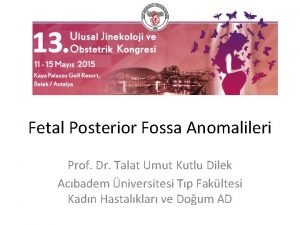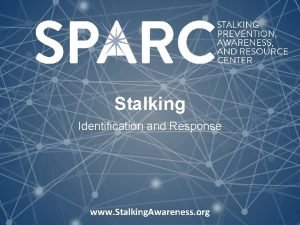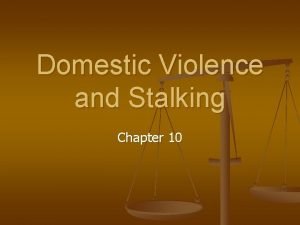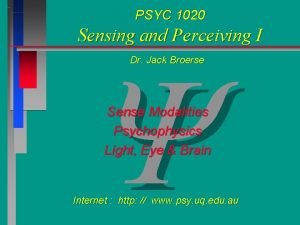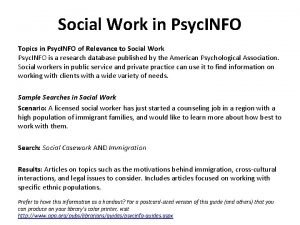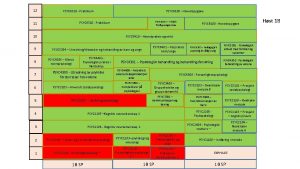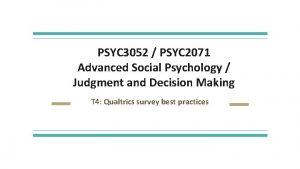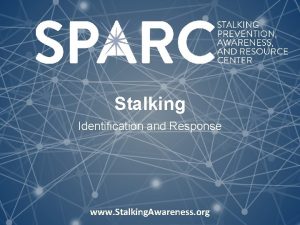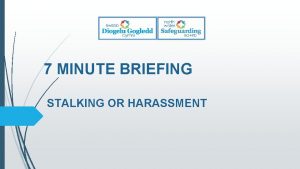PSYC 493 FORENSIC PSYCHOLOGY STALKING Assist Prof Dilek



































- Slides: 35

PSYC 493 -FORENSIC PSYCHOLOGY STALKING Assist. Prof. Dilek ÇELİK

STALKING- PSYCHOLOGICAL TERRORISM. . . • Stalking is intentional or unintentional mind games intended to elicit fear and compliance from the intended target. • “ I have an obsession with the unattainable. I have to eliminate what I cannot attain. ”

Stalking • (i) a pattern of intrusive behavior or harassment; • (ii) a resulting implicit or explicit threat; and • (iii) that causes the threatened person to experience reasonable fear.

FACTS • THE MAJORITY OF STALKERS ARE MEN WHO PREY ON WOMEN (77%) • APPROX. 75% OF ABUSIVE RELATIONSHIPS THAT END RESULT IN STALKING BEHAVIOUR. • FEMALE VICTIMS • • 58% WERE STALKED BY SOMEONE THEY HAD BEEN INTIMATE WITH 24% WERE STALKED BY CASUAL ACQUAINTANCES 3% WERE STALKED THROUGH A WORK RELATIONSHIP 7% STALKED BY A STRANGER

FACTS • MALE VICTIMS • • WERE USUALLY STALKED BY A CASUAL ACQUAINTANCE MALE VICTIMS ARE MOST OFTEN STALKED BY ANOTHER MALE 9% WERE STALKED BY AN EX-SPOUSE 4% WERE STALKED BY A CURRENT OR FORMER GIRLFRIEND

VICTIMOLOGY • 1 in 12 Woman • 1 in 45 Men • Majority of victims: 18 to 29 yrs

Duration of Stalking • • • Less than 1 year 52% 1 to 2 years 16% 2 to 5 years 23% 5 years or more 9% On average, stalking cases last 1. 8 years (21 months) Stalking cases involving current or former intimate partners last significantly longer than stalking cases involving nonintimate partners.

Why does stalking stop ? • • The victim moved 19% Stalker got new love interest 18% Police warned stalker 15% Victim talked to stalker 10% Stalker was arrested 9% Stalker moved 7% Stalker got help 6% Unexplained, it just stopped 1%

Dynamics of Stalkers • • Can be anyone Extreme emotional needs Relentless and determined Manipulative/sometimes clever Substance abuse and propensity for addiction May be delusional Consider their actions normal Information Freaks

Common Traits • • • Obsessive personality Above Average Intelligence Few personal relationships Non-conformity to societal norms Low self esteem


TYPOLOGIES OF STALKERS • Zona’s Stalker–Victim Types • Mullen’s Stalker Typology • The RECON Typology of Stalking

Zona’s Stalker–Victim Types • Zona, Sharma, and Lane identified distinct stalker–victim types dividing stalkers into three categories: • (i) simple obsessional, • (ii) love obsessional, and • (iii) erotomanic

Zona’s Stalker–Victim Types • 1 -Simple obsessional cases • by far the most common, • a stalking perpetrator and victim have some prior knowledge of each other, and very often some prior relationship. • This relationship may be in the context of a work environment (employer–employee), medical setting (physician–patient), or may be an intimate relationship. • motivated to coerce the victim back into the previous relationship or to exact revenge for a one-sided termination of the bond. • Because there are fewer barriers to engage in physical contact between stalker and victim, these cases have the highest potential to result in violence

Do the protective measures work or stop the stalker?

Zona’s Stalker–Victim Types • 2 - Love obsessional stalking • The stalker and stalked person (victim) have no prior relationship. • These stalkers are the type that victimizes celebrities, known as the prototypical “obsessed fan. ” • Stalkers who perpetrate this type of behavior are more likely to have a DSM axis I diagnosis of severe and persistent mental illness such as schizophrenia, schizoaffective, or bipolar disorders. • Stalkers in this category will often focus on their victim after seeing him or her in public forum via media outlets. • The extreme examples of these cases, such as when Robert Bardo shot and killed actress Rebecca Schaeffer.

Rebecca Schaeffer Case Robert John Bardo shot and killed Schaeffer on Tuesday, July 18, 1989 at her West Hollywood residence. He was a fan who had been stalking her for three years. [ He then wrote numerous letters to Schaeffer, one of which she answered. In 1987, he traveled to Los Angeles hoping to meet with Schaeffer on the set of My Sister Sam, but security turned him away. He returned a month later armed with a knife, but security guards again prevented him from gaining access. Bardo watched Schaeffer in the black comedy Scenes from the Class Struggle in Beverly Hills in 1989, in which she appeared in bed with another actor. He became enraged by the scene, apparently out of jealousy, and decided that Schaeffer should be punished for becoming "another Hollywood whore’’.

Zona’s Stalker–Victim Types 1 -Erotomanic stalking • a stalker delusionally believes that the stalking victim is also in love with them. • The rarest within Zona’s classification system, • its overlap with the DSM-V diagnosis of delusional disorder, erotomanic type. • A unique characteristic of this group is that the majority of stalkers are females, often young women, whose victims are classically men of higher socioeconomic status. • Movie recommendation- ‘’He loves me, he loves me not’’

Movie Quotes • There's a world in my head an unreal world In it, Loic loves me and protects me In it, he's always at my side Now I know it doesn't exist that it was an illusion the fruit of my imagination We all dream of a great love affair I just dreamt a bit harder.

Mullen’s Stalker Typology • In 1993, Australian stalking expert Paul Mullen, clinical director and chief psychiatrist at Victoria’s Forensicare, a highsecurity hospital for mentally ill offenders, analyzed the behavior of 145 diagnosed stalkers. • • • 1 -Rejected, 2 -Intimacy seeking, 3 - Incompetent, 4 - Resentful, and 5 - Predatory

Mullen’s Stalker Typology • 1 -Rejected • As a result of relationship dissolution, stalker desires a mixture of reconciliation and revenge. • Former intimate relationship • Experiences feelings of loss, frustration, anger, jealousy, and depression. • Most likely to assult their victims • 2 -Intimacy seekers • Seek out an intimate relationship with their victim that is typically romantic, but not necessarily so. • This stalking behavior includes those with morbid infatuations and erotomanic delusions. • Stalkers in this category are commonly isolated, socially inept, and possibly psychotic.

Mullen’s Stalker Typology • 3 - Incompetent • Intellectually limited and socially incompetent individuals desiring intimacy. • Lack sufficient skills in courting rituals. • May display a sense of entitlement. • They are not infatuated, only attracted.

Mullen’s Stalker Typology • 4 -Resentful stalkers • Harass their victims with the specific intention of causing fear and apprehension out of a desire for retribution for some actual or supposed injury or humiliation. • The resentful stalker experiences feelings of injustice and desires revenge against their victim rather than a relationship. Their behavior reflects their perception that they have been humiliated and treated unfairly, viewing themselves as the victim. • The harassment is sustained by the satisfaction the stalker obtains from the sense of power and control. • This group frequently issues overt and covert threats but rarely resorts to physical violence in general.

Mullen’s Stalker Typology • Mark Chapman, the notorious John Lennon stalker and murderer is a classic case of a resentful stalker. He described himself as the world’s biggest rock fan and admired Lennon and all his work, until he read a biography of the musician. Angered that Lennon would “preach love and peace but yet have millions [of dollars], ” • Chapman shot and killed Lennon on December 8, 1980. • In later testimonials, Chapman described how his father “never told me he loved me; and he never said he was sorry. ”

Mullen’s Stalker Typology • 5 - Predatory Stalkers • stalk for information gathering purposes or fantasy rehearsal in preparation for an attack, usually sexual and voyeuristic gratification. • The stalking is covert so as not to alert the victim to the impending attack, but some predatory stalkers derive pleasure from making the victim aware of being watched without revealing his or her own (the stalker’s) identity. • Least common

The RECON Typology of Stalking • RECON classification system for stalking behavior that separates stalkers into four groups based on two key domains. • (i) the nature of the previous relationship between stalker and victim (relationship, RE) and • (ii) the context in which this relationship was based (context, CON) as predictive of distinct categories of stalkers, especially as they related to predicting risk of violent behavior. • Under this classification scheme, intimate and acquaintance stalkers (type I) have had previous relationships with their victims, while public figure and private stranger stalkers (type II) have not.

The RECON Typology of Stalking- Type I • Intimate stalkers, • those whom have been involved in an intimate relationship (marriage, dating, sexual, cohabitating) with their victim. • this group was the largest, making up 50% of all stalkers. • This group was by far the most dangerous, being the most likely to be violent, to use or to threaten use of weapons, to exhibit suicidal ideation or behavior, and to abuse alcohol or other illicit substances. • The majority are men, and recidivist stalking behavior is near-universal despite protection orders, incarceration, or other deterrents to such behaviors. • Acquaintance stalkers, are known to their victims but have not been involved in an intimate or sexual relationship. • Examples of such relationships include work and other professional relationships, nonintimate friendships, and clinician– patient interactions. • Strong desire to initiate a relationship, with sporadic pursuit patterns that often last years. • They are less prone to violence than intimate stalkers,

The RECON Typology of Stalking- Type II • Type II stalkers consist of individuals who have had no contact or only incidental contact with their identified victim • one-third to one-half of stalkers, • Public figure stalkers or “celebrity stalkers” are those who stalk public personalities with whom they have no prior relationship. Stalkers in this category are more likely to be psychotic, female, and have male victims. • Despite sensationalized cases that garner media attention, celebrity stalkers are unlikely to threaten their victims or perpetrate violence. • Finally, private stranger stalkers are those who stalk someone who is not a public figure with whom they have no prior relationship. • Mostly made up of men with serious and persistent mental illnesses. • Up to one-third becoming violent in some capacity against either the stalking object (victim) or his or her property.

Overlap between different typologies

Contact made by Stalker • • Telephone calls– 87% Surveillance of home– 84% Followed– 80% Drive by home– 77% Appearing at workplace– 54% Sent letters– 50% Made other types of contact– 49% Spread gossip– 48%

STALKER LETTER 1

False Victimization (FV) • • Very rare (2%) Usually females Turns out the victim is actually the perpetrator Attention seeking behavior

FVS Red Flags • • • Come forward gleefully Wants to share all the details Expresses little fright Seems to be enjoying the attention Encourages police/3 rd parties to set up a “meeting” so they can talk to stalker

FVS Red Flags • Many FVS have history of self mutilation • Suicide attempts • False claims often follow major life distressors or dramatic moments

Psychosocial Impact on Stalking Victims • • • Anxiety (83%) Sleep disturbances (74%) Overwhelming Powerlessness (75%) Flashbacks/Intrusive recollections (55%) Fatigue (55%) Weight fluctuation (48%) Headaches (47%) Reduced social outings (70%) Reduction in work/school attendance (53%) Relocation (39%) Change in workplace, school, or career (37%)
 Who is this
Who is this Prof dr dilek erdem
Prof dr dilek erdem Posterior fossa anomalileri
Posterior fossa anomalileri Klaritomisin
Klaritomisin Slii framework stalking
Slii framework stalking What is the rhyme scheme of the tiger in the zoo
What is the rhyme scheme of the tiger in the zoo Stalking
Stalking Killing stalking chapter 10
Killing stalking chapter 10 Pathologist and anthropologist
Pathologist and anthropologist Fill my cup lord hymn
Fill my cup lord hymn Glory glory hallelujah sda hymnal
Glory glory hallelujah sda hymnal Round 493 295 to the nearest ten thousand
Round 493 295 to the nearest ten thousand 295 rounded to the nearest ten
295 rounded to the nearest ten 632 rounded to the nearest ten
632 rounded to the nearest ten Educational sport psychology specialists
Educational sport psychology specialists Psyc 311
Psyc 311 Psyc 1504 final exam
Psyc 1504 final exam Psyc 311 textbook notes
Psyc 311 textbook notes Psychology final exam review
Psychology final exam review Psyc 1020
Psyc 1020 Psyc 311 study guide
Psyc 311 study guide Psyc info
Psyc info Psyc info
Psyc info Psyc info
Psyc info Sfu library search
Sfu library search Psyc 1504 final exam
Psyc 1504 final exam Psyc info
Psyc info Psyc 2120
Psyc 2120 Psyc 2307
Psyc 2307 Forensic psychology serial killers
Forensic psychology serial killers Forensic psychology serial killers
Forensic psychology serial killers Serial killers forensic psychology
Serial killers forensic psychology Forensic psychology lecture
Forensic psychology lecture Forensic psychology history
Forensic psychology history Introduction to forensic psychology bartol pdf
Introduction to forensic psychology bartol pdf History of forensic psychology
History of forensic psychology


